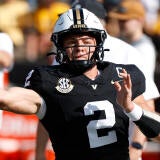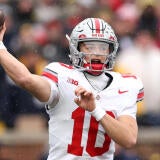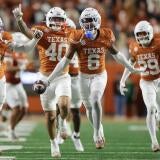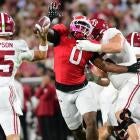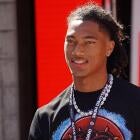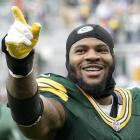Why showing 'guts' in the pocket remains the most underrated quality quarterbacks possess
Being a successful quarterback is about more than arm strength and intelligence
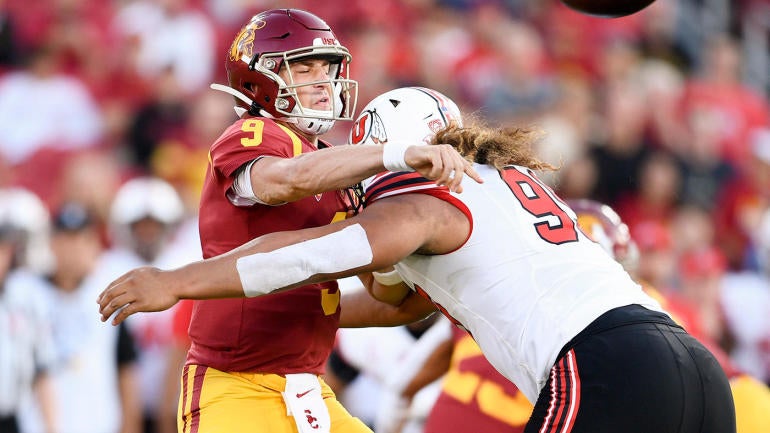
USC quarterback Kedon Slovis traces his "guts" back to sixth grade. It was there, during his introduction to tackle football, that his father laid down an edict: You can quit if you don't like it, but you can't quit in the middle of the season.
"We're making it through the season," Max Slovis told his son.
"My team was terrible," Kedon added. "I got clobbered every game. My dad was like, 'If you get hit, you've got to be the tough guy. You've got to take the hit when you're throwing the ball.' That season set the standard. You get hit; you get right back up."
Perhaps the ball has never been in the quarterback's hands more than in this era combining RPOs, increased passing and the emergence of the dual-threat signal caller. No position is as analyzed as quarterback. But there's one aspect of the position that can't be measured accurately with numbers.
How does a coach know a quarterback has the intestinal fortitude, the guts to stare down a blitzing linebacker or get up and do it all again after taking a major hit? More than that, where does the trait come from?
Not only does a quarterback have to stand pat against a defender bent on taking his head off, he has to get the ball out knowing pain is coming before the end of the play. His own.
"I don't think it's talked about enough, what the position is," UCLA coach Chip Kelly said. "There's not an NFL or college football quarterback that doesn't get hit. It's a different kind of toughness. You're not the one inflicting the physical punishment. You're the one taking the physical punishment.
"Oh, by the way, you're supposed to zip a 20-yard dig route in between the safety and corner."
Prior to the COVID-19-shortened 2020 season, the top seven seasons for average pass attempts per game had occurred between 2005-15. Not surprisingly, the top four marks for sacks in a game by an individual have all come since 2005.
Quarterbacks are passing more, but they're also bearing more of the pain for their effort.
Slovis enters his third season as the Trojans' starter having taken his share of punishment. Since he became the starter in 2019, only three Pac-12 teams have allowed more sacks than USC (43). Nevertheless, Slovis returns in 2021 as the Pac-12's leading returning passer (1,921).
The junior has already sustained three significant injuries from hits: a concussion at Utah, an elbow injury against Iowa and a shoulder injury against Oregon.
Slovis takes pride that those injuries came from him attempting to get the ball downfield, not covering for a sack. The teachings of Max endure.
"I'm not a huge talker," Slovis said. "When people talk to me, I don't really hear it. If you're 300 pounds and I'm 200 pounds, you can't even hurt me. It's that kind of approach. Take your best shot. I'm vulnerable, too, but I'm going to pop right back up."
North Carolina's Sam Howell might get the nod as the game's "gutsiest" returning quarterback. The Heisman Trophy contender was the nation's best passer against pressure last season, according to Pro Football Focus: No. 1 in pass efficiency (188.1), No. 1 in yards per attempt (11.73), No. 4 in completion percentage (53.6%), No. 2 in touchdown percentage (13.1%) with at least 30 attempts. Only five returning FBS quarterbacks had a higher percentage of first-down passes when pressured.
"I think it's something some people develop and some people don't," Howell said.
Tennessee is desperate for a capable quarterback, but do Volunteers fans realize what analytics have dropped in their lap? Virginia Tech transfer Hendon Hooker has been the most efficient quarterback against pressure the last two seasons combined among returning quarterbacks (minimum 60 passing attempts).
Against pressure, Hooker has a 176.2 passer rating since 2019. Over a full regular season, that would have placed him in the top 10 nationally slightly ahead of Ohio State's Justin Fields in 2020.
You want big-play ability? Oklahoma State's Spencer Sanders may have been plagued by turnovers in his career, but there was no more explosive passer against pressure the past two seasons averaging 19.85 yards per completion.
"It's not anything anybody ever talks about. It's the secret sauce to playing that position," SMU coach Sonny Dykes said, "to see past a blitzing safety that you know is going to hit you right in the middle of the chest and focus on some receiver 25 yards downfield. That's why sometimes the big [teams] with the big [quarterbacks], if they don't have that characteristic, what's the point?"
Dykes' crowning achievement over a 28-year coaching career might be Jared Goff. At Cal from 2013-15, Dykes developed what would become a Super Bowl quarterback with the Rams.
"If you go back and look at Jared's tape, you'd say, 'Above average arm, above average accuracy, above average work ethic and intelligence,'" Dykes said. "But you go back and you watch the tape, I've never seen a quarterback at any level who could stand in the pocket and not be affected like he could. Never saw it beforehand. Never saw it since. Completely unaffected by the rush. That's what made him the first pick in the NFL Draft."
Arizona State coach Herm Edwards says the ability to pop back up after a hit delivers "instant credibility" with a quarterback's teammates.
"A guy goes back and throws 40 passes, and the camera always watches the ball," Edwards added. "They don't keep it on the quarterback. There's about 15 times during the game he's getting hit and knocked to the ground. It's a tough job, man, it's tough."
That's another way to look at the "guts".
Feel sorry for the likes of Josh Jackson, who opted out of the 2020 season at Maryland and whose career is likely over. But in 2019 as Maryland's starter, he faced a blitz on almost 58% of his dropbacks. That figure is the highest for all FBS QBs combined since 2019. Feel sympathy for Wake Forest's Sam Hartman, who has played 13 games in the last two seasons facing a blitz 48.5% of the time on his dropbacks. Respect Boston College's Phil Jurkovec, who led the country throwing 12.5 passes per game against pressure. That might explain why the Eagles went from No. 4 nationally in sacks allowed (leading the ACC in 2019) to 105th in 2020.
"The best feeling is when they're getting ready to hike the ball, getting set, and they're double checking for you," said Oregon All-American defensive end Kayvon Thibodeaux. "You can see those eyes. They keep coming at you."
Thibodeaux might be the nation's No. 1 factor in a quarterback's gut check. The national defensive player of the year candidate has 23.5 tackles for loss in 20 career games.
Bravado only goes so far, though. Geoff Schwartz once protected Dennis Dixon at Oregon when the quarterback was the Heisman leader late in 2007. Dixon, already nursing an injured knee, went down untouched during a Thursday night game. Dixon's Heisman and the Ducks' championship hopes were done.
"The best quarterbacks in the NFL and college football aren't getting hit very often," said Schwartz, an eight-year NFL veteran offensive lineman. "It's not because their offensive lines are [necessarily] great. Joe Burrow at LSU was running for his life. He knew where the pressure was coming from, and he knew his outlet [receiver].
"Just standing in there and getting hit, sometimes it's great that you're tough. It doesn't mean that you're good."
This inexact science has its own culture. No coach worth his whistle allows his quarterback to be hit in practice. Supplementing that protection, coaches have been known to teach quarterbacks how to fall when hit as a method of reducing injury risk. That's like going from 0-60 in a Porsche in 4 seconds, because when the bullets fly in a live game, there is no escape.
"Are they skittish in the pocket?" Oregon center Alex Forsythe asked. "As soon as they feel an ounce of pressure, are they going to run out of the pocket and possibly give up a sack?"
Once that happens, Forsythe said, "That's out of our jurisdiction."
Still, no offensive lineman wants the disgrace of giving up a sack. The failure exists in the moment and on tape for coaches to harp on throughout the ensuing week. Might as well also feel sorry, then, for Kansas, which gave up the most sacks in the nation (47) last season.
"It's the worst feeling," Forsythe said. "You want to protect your quarterback as much as possible. He's the President, and you're the Secret Service. You've got to protect him at all costs."
For Slovis, there is a bit of irony. Perhaps the only reason he might be starting at all at USC is the injury JT Daniels suffered in 2019. In the opener, Daniels injured his ACL and was knocked out for the season. He subsequently transferred to Georgia where he wasn't cleared to play until the final four games of 2020.
In other words, Daniels stood tough. Look what it got him. Slovis took over as a freshman perhaps expecting to redshirt behind an established starter that year. He hasn't left the lineup since.
"You're the backup quarterback," Slovis said. "Everyone says you're only a play away."
Guts or no guts.


